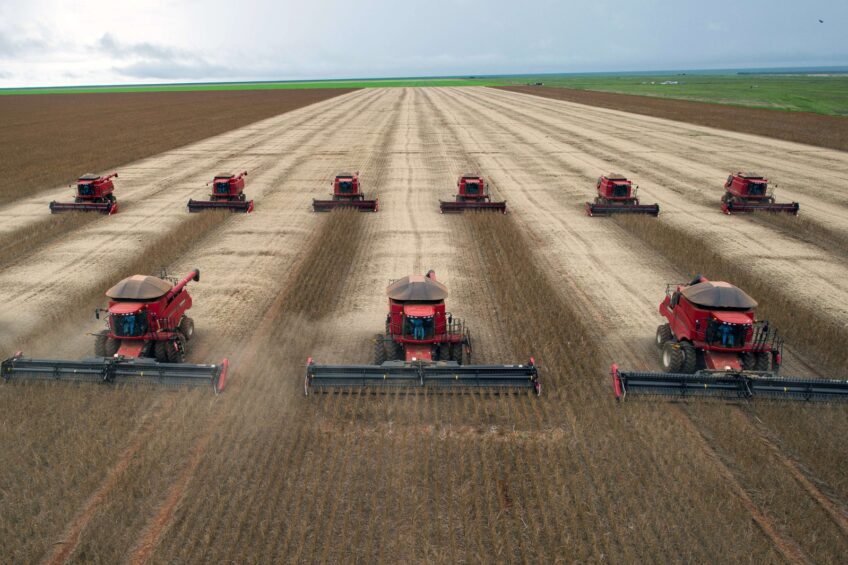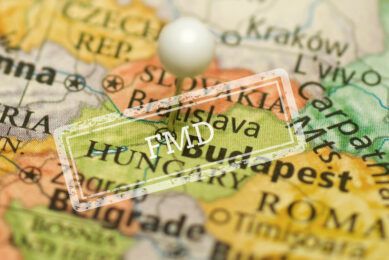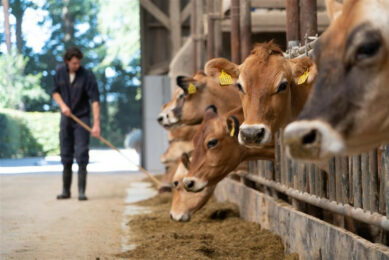Soy – the dairy sector’s Achilles heel

The euphoria about growth of the European dairy sector pushes possible risk factors to the back of the mind. However, it is of the utmost importance to closely monitor these risk factors. One of these is the dependence on soy imports from the Americas. A sub optimal harvest may lead to a ‘soy war’ between Europe and China, with severe price consequences influencing farm profitability.
In the dairy farming sector all signs indicate strong growth. New dairy processing plants are being established and existing ones are expanding. For the time being, the demand for dairy products will increase globally and in parts of Europe milk production may grow to 20% towards the abolition of the milk quota system in 2015. Meanwhile dairy experts expect the milk price to fluctuate, although the lowest level will be at a higher level than it has been in the last decade. In short, the near future looks positive and there is a sense of realism about the risks on the profit side. But how does an increase in milk production in the EU countries affect the robustness of the sector as a whole? More milk requires more funding for investments, more cows, more feed concentrate, more roughage and more chemical fertilisers. All of which is amply available now, but some are guaranteed to become scarce at some point.
Pressure on markets
There are some developments that give food for thought. The price of feed concentrate on the one hand and on the other milk prices are volatile and are on average higher then farmers are used to. The growing world population and growing prosperity, especially in the developing world, put upward pressure on markets for grains, corn, rice, soy, sunflower, tapioca and rapeseed. At the same time a relatively wealthier world population will consume more animal protein, resulting in a bigger demand for feed ingredients. Knowing that food and feed markets are interconnected and that both demand more, there is hardly any margin for a sub optimal harvest anywhere in the world.

A relatively new addition to the equation is the competition with biofuels. This industry has increased considerably in size over the last ten years due to blending objectives in the US and Brazil. As a side effect energy, food and feed prices have a much stronger effect on each other.
Finally, climate change causes extreme weather conditions to occur more often, including tornadoes, torrential rain or extreme drought. Crops fail more often and countries and supply lines are disrupted. To make things worse; peaks in feed prices do not necessarily coincide with peaks in the milk price. As some farmers in intensive farming systems (i.e. eggs) know, farm profitability can go up and down with the same spikes and volatility as feed and milk prices, with long down runs sometimes resulting in farm bankruptcies due to not being on top of animal or financial management.
In short, it is less obvious imported concentrate ingredients will be available. Production growth can’t keep up with the sustained demand and stock levels are low. Therefore a small change in the export of countries and regions immediately affects world market prices. The tensions in Ukraine and Russia already affect wheat prices, as the Black Sea region is a large exporter of wheat. The impact on concentrate prices for dairy cattle remains limited, since the EU still has its own wheat provision and there are alternative resources.
Soy import the Achilles heel
A steady supply of soy as the favourite protein source in feed concentrate needs to be a completely different story in the near future. The soy used in Europe as well as in large parts in China originates largely from Brazil and smaller portions from Argentina and the US. In recent years reports appeared with words of warning concerning this dependence. Via the Dutch port of Rotterdam, a main entry point for feed ingredients from overseas, annually some 9 million tonnes of soybeans are channelled from here to other EU countries. Still the Netherlands is only a relatively small player in the overall global soy wars. China takes a huge piece of the pie with a mega purchase of 59 million tonnes of soy from the world market. That demand will increase considerably over the next six to eight years. According to the American Department of Agriculture (USDA) this increase could be 59%. These are impressive numbers, illustrative for the meaning of ‘pressure on the market’.
In case the South-American soy crops plunge due to drought or a plant disease, this would need to be balanced by a very good harvest in the US, India or China. If these crops are meagre too, prices will skyrocket. It is conceivable that China will quickly purchase stocks out of strategic importance, after which time no single bean will be available for sale anywhere else.

Intensive most vulnerable
No soy or unaffordable soy, just how serious is that for the dairy sector? Less severe than it would be for the pig and poultry sectors, in which feed concentrates represents a large portion of the cost price. In the dairy sector an average of 11% of soy is used in feed concentrates. Soy has a favourable amino acid ratio, but when it is unavailable the farmer will seek alternatives. The availability of alternatives is limited, and therefore expensive. The abolition of soy has a dual effect. Alternatives make concentrates more expensive and depending on the
protein level in the silage (or fresh grass) production declines.
The question is whether soy is the Achilles heel of the dairy sector. It is certainly vulnerable, but there are more components. A shortage of soy pushes all prices up, including those of corn and grains. Countries will take measures to control domestic food prices, resulting in even higher prices on the world market. Speculation reinforces such effects. In the event of multiple factors being present together, a serious problem arises.

Intensive dairy farming, without enough land to satisfy their own feed needs, is a liability. In addition to that, ground based dairy farming and its benefits for animal health, is yet another reason not to go all in when it comes to intensification. After all, intensive dairy farms which purchase large amounts of feed and must remove lots of manure, are, in such a crises, most vulnerable.
Finding other protein sources
The buyers for feed manufacturers in Europe acknowledge that a bottleneck has formed. Soy is currently still easily
available, including sustainably grown soy. They say: “Pressure on the market is increasing enormously. In the long term there is a chance that the Chinese will stand on our trade partners’ door step and say: we will pay a little extra and will not make a fuss. Send those ships over to us”.
Also for the sake of the objective of sustainable dairy and food security the dairy and feed manufacturers think alternatives for soy should be found over the next decade. The EU should grow more peas, lupines and eventually also soy. Algae, seaweed or farmed insects can also provide protein. European feed manufacturers barely dare to name usage of animal meal as an option, twelve years after the BSE-crises. “That is still a very sensitive issue”.
Join 13,000+ subscribers
Subscribe to our newsletter to stay updated about all the need-to-know content in the dairy sector, two times a week.










